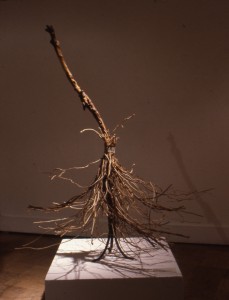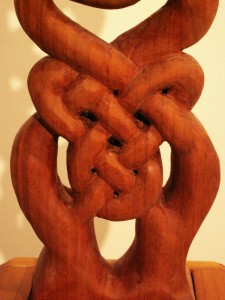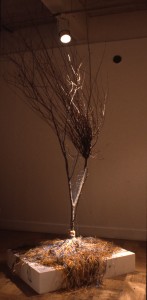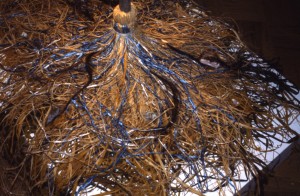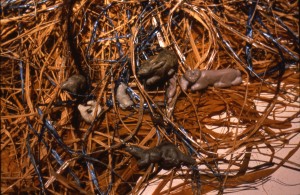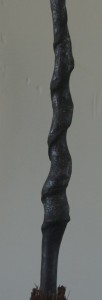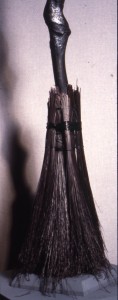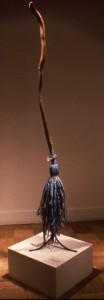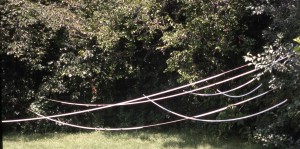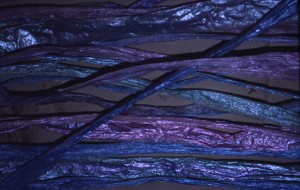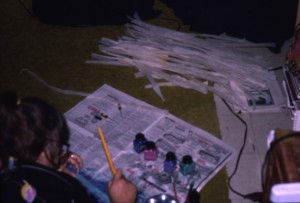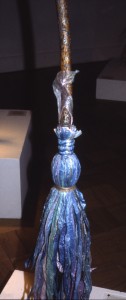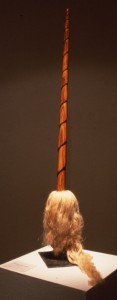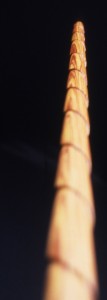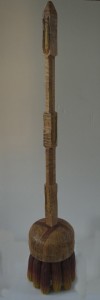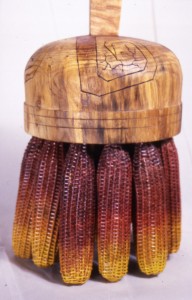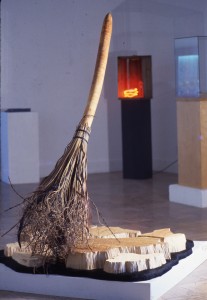 Curly Maple, ting-ting, barbed wire, basswood, felt.
Curly Maple, ting-ting, barbed wire, basswood, felt.
Wow! It has been over 8 weeks since my last post! Apologies for those who might be waiting for them.
This is the last broom in the collection. Only parts of it remain now, some were recycled by Rae for other pieces, and the whole was too many pieces and too difficult to box to maintain as a piece.
The piece was done as part of an anti-Gulf War show. I don’t remember when the show was, nor who organized it. Since it was during Desert Storm, it would have been 1990. From the photograph, I’d say it was the 7th Floor Gallery at the Humanities Building on the UW-Madison campus. Rae did leave behind her Artist’s Statement concerning it, which I reproduce below.
The broomstick is a thick, somewhat subtle phallic shape, (for Rae it was subtle!) made of a solid block of curly Maple. It was carefully rounded and shaped, and brought to a high polish. If you looked closely at the top, there was even a slight ridge. The skirt is strands of barbed wire, and a variety of floral shop selections, some with sparkles, some curling, so that the impression is that of the trails behind a missile lifting off.
Below the broom are a set of carved pieces of Basswood, cut into the shapes of the countries of the middle-east, though not to scale. These were placed on a thick, irregular foam base, wrapped with black felt.
The other pieces she mentions below were never completed.

When the patriarchy sweeps
As an artist, I have the opportunity and the means to express my: hopes, fears, concerns, anger, love, political beliefs and spirituality in a visual way. My process can become a catharsis, a discharge and an exploration into my emotions, passions and thoughts. And as an artist, I am even egotistical enough to believe that the work/piece that comes out of this process — may make a difference: by supporting and validating the perceptions of some and by giving others and insights into a different perspective. Or by just being manifested into the world.
In magical societies the process of “making”, begins the process of transformation and change. When I heard the words “War is sweeping across the Middle-East today” and “As Desert Storm sweeps across the Middle-East” — my years of anti— war activism felt like a waste. I became glued to the TV like the rest of the US. But with each stroke of that camera — I became stronger in my resolve to make the art explored my concerns and despair. To begin the process of making/transforming/changing this reaction to all war, at least within myself.
War is wrong, there has to be another way to resolve conflict. The devastation of cultures is wrong. And when war, when the Patriarchy sweeps over an area, that area is torn apart. Its culture is devastated. Both the victims and the aggressors are injured. And the victims of war are not limited to soldiers or resistance fighters. Is what they called civilians/collateral damage. That “damage” is women, children, the disabled and elderly.
When the Patriarchy Sweeps, is the first in a series of broom sculptures called SWEPT OVER. This is a war broom and speaks of the tearing apart of her region. It decries the devastation of cultures. He reveals the patriarchal assumption of its rights to have power over. It mourns victims of war — the women, children and others of all sides. When there is an “enforced peace”, who cleans up the devastation… I hope it expresses the need for true Peace.
RAE ATIRA-SONCEA
